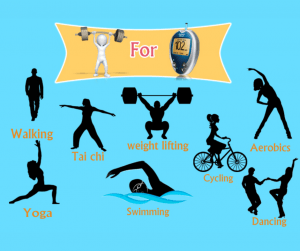Exercise to beat Type 2 diabetes mellitus

Type 2 diabetes cases are very high in India. It can prove very harmful if neglected. A lifestyle disease, diabetes is very common due to changing diets and a sedentary lifestyle. If you have diabetes, being active makes your body more sensitive to insulin (the hormone that allows cells in your body to use blood sugar for energy), which helps manage your diabetes. Physical activity also helps control blood sugar levels and lowers your risk of heart disease and nerve damage.
How does Type 2 Diabetes Mellitus happen?
First, let’s look at how Type 2 diabetes affects blood sugar (glucose) levels. Your pancreas makes insulin, which allows your cells to obtain blood sugar and use it as energy. Your cells do not respond normally to insulin (insulin resistance), and your pancreas makes more to compensate. This makes your blood sugar rise, leading to a prediabetes or Type 2 Diabetes diagnosis.
Fortunately, physical activity can help you manage the effects of Type 2 diabetes.
Exercises help:
- Lower blood sugar levels: An exercise routine may lower blood sugar levels over time.
- Help cells respond to insulin better thus allowing cells to use the hormone more effectively.
- Contribute to healthy weight loss which may prevent or reverse Type 2 Diabetes.
- Reduce the risk of cardiovascular disease
- Maintain muscle strength
General guidelines recommend that people with Type 2 diabetes do aerobics and strength training exercises every week. Strength training or aerobics can help you manage your blood sugar. But a combination of the two may be even more effective.
According to these guidelines, you should aim for 150 minutes of aerobics and two to three strength training sessions every week. The American Diabetes Association (ADA) suggests daily exercise to meet these goals. But if that doesn’t work with your schedule, they recommend not skipping your workout more than 2 days in a row.
These recommendations are not appropriate for everyone with Type 2 diabetes. For example, weight lifting or high-intensity aerobics may not be safe if you have certain medical conditions in addition to diabetes. So, it’s best to consult with your healthcare provider before starting any regimen.
10 exercises to help you manage Type 2 diabetes
A well-rounded exercise routine should include a variety of activities. These workouts can help you improve and maintain your fitness, strength, and flexibility.

Here are 10 ideas to help you get started:
-
Walking
Walking is a low-impact activity that many people enjoy. Getting your steps can improve your blood pressure, glucose, and cholesterol levels. And 30 minutes of brisk walking –– or about 100 steps a minute –– is a great way to meet the ADA’s recommendation for daily aerobic exercise.
You can also boost the intensity of your walks by adding activities like stair climbing. But if you weren’t active before your diabetes diagnosis, consider starting slowly and gradually upping the pace.
-
Running
With proper training –– and your healthcare provider’s approval –– you can work your way up from brisk walking to running. This faster-paced activity has been linked to a reduced risk of high blood pressure, high blood sugar, and high cholesterol.
-
Cycling
There’s a reason stationary bikes have become so popular. Regular bicycling can improve everything from your heart and lung health to your balance and posture. But you don’t need an expensive fitness bike to get started. You can grab an old bike and hit the outdoors or try a stationary bike at your local gym. And research shows that cycling can improve health outcomes for people who have diabetes.
-
Dancing
Adding dance to your routine can make your workouts more fun. Dancing is a heart-healthy activity that can also improve your fitness and blood sugar levels. One study found that people with Type 2 Diabetes who participated in a dance program were more motivated to stick to a routine than those who did a different fitness program.
-
Water aerobics
There are plenty of reasons to take your workout to the pool. Water exercises like swimming are easy on the joints and may reduce blood sugar levels. They may also boost overall fitness, strength, and heart health in people with Type 2 Diabetes.
-
High-intensity interval training
With HIIT, you switch between short bouts of high-intensity activities and longer bouts of lower-intensity moves. You can add it to various exercises like running and cycling. If you have Type 2 diabetes, HIIT may decrease your fasting blood sugar.
-
Weight training
This form of strength training uses weights or other equipment to build or maintain muscle mass and strength. And it may increase insulin sensitivity and glucose tolerance in people with Type 2 Diabetes.
-
Yoga
Yoga involves low-impact movement, meditation, and breathing. It can improve balance, flexibility, and strength. This is especially helpful for older people with Type 2 Diabetes who might be at greater risk of falling. The practice may also help you manage your blood sugar and cholesterol levels.
-
Tai chi
Tai chi also combines low-impact moves, meditation, and breathing techniques. The ancient practice promotes better balance, range of motion, and overall well-being. And adding it to your fitness routine may lower your blood sugar.
-
Pilates
Another low-impact form of exercise, Pilates earns a spot on this list for good reason. It uses repetitive movements and breath control to strengthen your core and improve your balance and posture. And a study showed that practicing Pilates helped participants with Type 2 Diabetes control their blood glucose.
Regular physical activity can help you manage Type 2 diabetes. According to the ADA, your fitness routine should incorporate multiple kinds of exercise, including aerobics and strength training. And doing several different activities you enjoy can help you make exercise a part of your daily life. It’s helpful to check with your healthcare provider about safety and best practices before you get started.
We, at Ramaiah Memorial Hospital, help you manage your regimen to beat Type 2 Diabetes Mellitus and lead a healthy and active life.
Consultant
Department of Endocrinology

